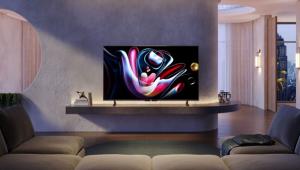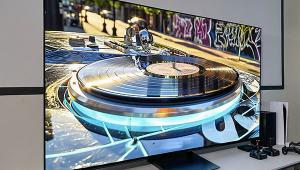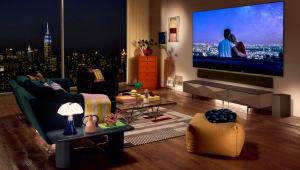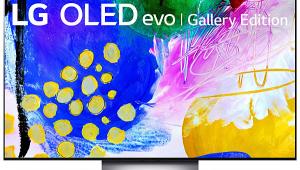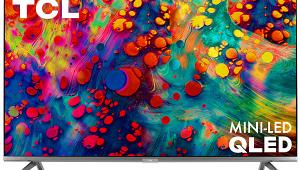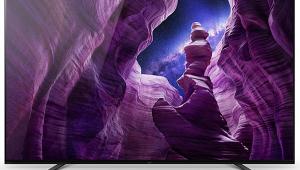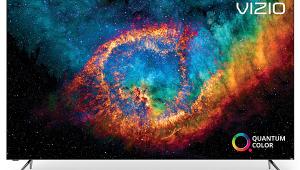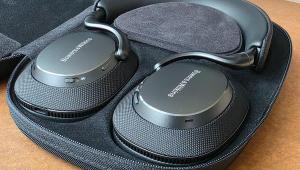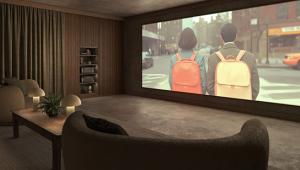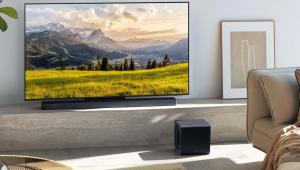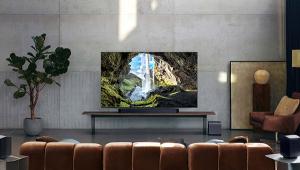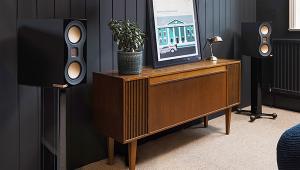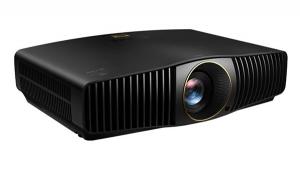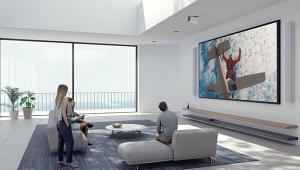Samsung 65" QN95D Neo QLED 4K TV Review

AT A GLANCE
Plus
Bright SDR and HDR peak luminance
Low input lag and new Game Bar
Attractive design, narrow bezel border
Attractive and snappy smart TV interface
Minus
Glossy screen shows reflections from room lights
Some noticeable blooming and shadow detail loss
No Dolby Vision support
THE VERDICT
The QN95D delivers solid performance, whether you're watching movies or live sports, especially in darker rooms. This is due in part to its glossy screen surface, which while effective does produce visible reflections from room lights. The backlight performance, in terms of brightness and dark scene presentation, is similar to that of last year's QN95C. The QN65QN95D is likely to represent a good value in the coming weeks and months as promotions begin. It is a particularly solid choice for gamers.
The QN95D is one of two televisions we went hands-on with on a recent trip to Samsung's New Jersey QA Lab, the other being the S95D quantum-dot OLED. We discovered an attractively thin 4K LCD display screen that produces an HDR picture as bright as last year's QN95C, with wide and accurate coverage of the professional DCI-P3 color space.
Samsung drives all the latest picture quality and sound processing systems with the new NQ4 AI Gen 2 Processor, equipped with 20 AI neural networks capable of generating improved picture depth for more dynamic immersion into the action. As with the new S95D Quantum OLED and the flagship Neo QLED 8K QN900D series, Samsung's 2024 premium 4K Neo QLED models produce a bright, colorful image from thousands of individual mini-LED backlights and expansive full-array backlight coverage outfitted with more than 1,300 local dimming control zones, affording a slight elevation in color brightness and shadow detail from a year ago.
Just like last year's QN65QN95C, the QN65QN95D handles ambient room light well, though it doesn’t entirely eliminate blooming or screen reflections when lights are on in the room. The QN95D proves a capable display for both movie and sports viewing, functioning almost as well in dark rooms as in day-lit ones, if you can shield sun or room light angles to mitigate screen glare.
Like all of Samsung's 2024 smart TVs, the Tizen v.8 OS is beefed up from 2023 to offer snappier menu navigation response to quickly access program suggestions from the large streaming app movie libraries or the growing lineup of cloud-gaming services.
The QN95D 4K Neo QLED LCD series will be available in a wide range of screen sizes including: 43-inches ($1,499 suggested retail price); 50-inches ($1,599); 55-inches ($1,999), 65-inches ($2,699), 75-inches ($3,299), 85-inches ($4,799) and 98-inches ($14,999). All models will have similar feature sets, though smaller screen models may have fewer mini-LEDs and local dimming zones, which will result in different peak brightness readings.
Design
The design of the QN95D series features a sturdy, thin-design pedestal stand made from a combination of plastic and metal. This stand, along with the channel ridges on the back of the television, facilitates neat cable management. The flat, slim back panel of the TV is just over 1 inch deep at the top, allowing for a relatively close fit when wall-mounted using an optional VESA-compliant bracket. However, similar to last year’s models, this series does not include the separate One Connect box that houses input and output connections. This omission means that the panel’s depth increases slightly toward the bottom to accommodate internal circuitry and cable connections.

The rear positioned I/O panel on the QN95D is easily accessible from the right side of the screen, which is convenient and does not interfere with wall placement. Cables can be efficiently organized into channels along the back of the set for a clean setup.
In terms of connectivity, the QN95D is well-equipped: it includes 4 HDMI 2.1 ports that support the screen’s 120Hz native refresh rate and up to 144Hz for gaming, 2 USB type-A ports, an Ethernet port for stable wired internet connections, a cable/antenna connector, and a RS-232 control port.
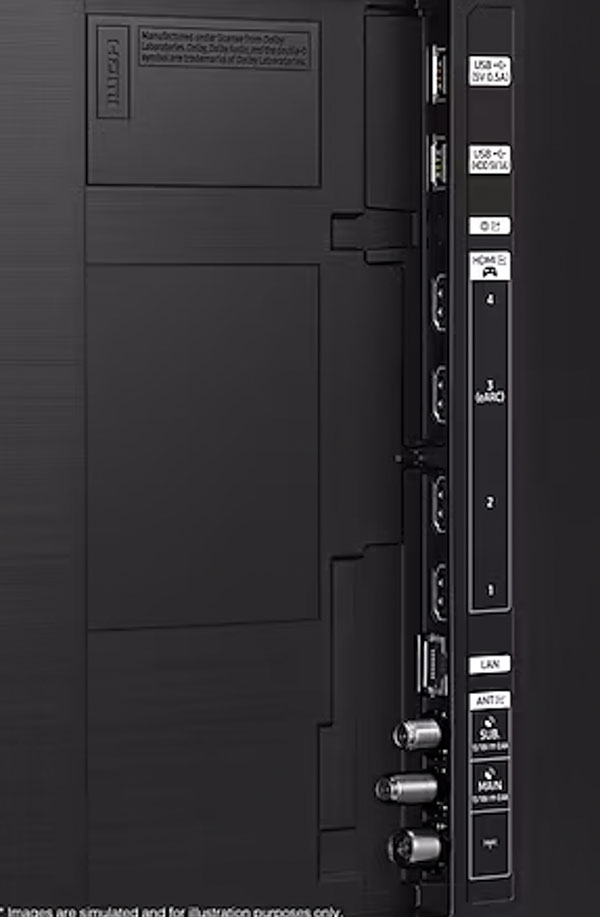
Samsung continues to use its solar-powered remote, now called the “SolarCell Remote,” that includes a mic input for voice commands to navigate set-up and app library options. Like the others, it also has a solar panel on the back to recharge the batteries from sun or ambient room light sources. The remote works well with Samsung Tizen smart TV OS 8.0 for 2024, is comfortable and easy to control with one hand, and offers great convenience by not requiring frequent battery replacement. Just remember to flip the remote over when not in use to expose the solar panel to room or daylight, or you can use a USB-C charging cable to power up again after a few minutes wait.
See The HDR Light
The QN95D supports a range of High Dynamic Range (HDR) formats, including standard HDR10, HDR10+ (Adaptive), and HLG. Consistent with their usual practice, Samsung does not support Dolby Vision. Dynamic metadata signals for that format will automatically default to the static HDR10 mode.
While the differences between these formats are typically subtle, those seeking a full dynamic metadata HDR experience may opt for HDR10+ supported movies and programs. Although the HDR10+ movie catalog is not as extensive as Dolby Vision's, it is continuously expanding.
In our testing, we measured the HDR10 peak luminance at 1,969 nits using a 10% D65 white window test pattern in Filmmaker Mode, which is roughly equivalent to last year's 4K Neo QLED QN95C. The set features an estimated 1,344 local dimming zones that control the thousands of mini-LED backlights, helping to achieve particularly good contrast performance for an LCD-based display. Measurements were taken with Portrait Display's C6-HDR colorimeter, a Murideo Six-G test pattern generator, and the latest version of Portrait Displays' Calman software.
.jpg)
Peak HDR10 Luminance exceeded 1900 nits measure in Portrait Display’s Calman software.
However, we noticed a bit of shadow detail crushing compared to Samsung's flagship QN900D 2024 8K Neo QLED model, notably during the challenging 'evil wizard attack' sequence from the 1080p Blu-ray of Harry Potter & the Deathly Hallows Part 2. Similarly, during the moving star field test patterns from the Spears & Munsil 4K UHD Blu-ray test disc, some stars appeared crushed at low brightness levels, and milky clouds were observed around star clusters. This effect was also present in the deep space background during the opening title sequence of The Martian on 4K UHD Blu-ray, a typical issue for TVs with LCD backlight illumination.
For those who prioritize shadow detail and black level purity in their viewing, an OLED set like this year's S95D QD-OLED series or similar models from LG or Sony, which feature self-emitting light sources, might be a better option.
Additionally, we observed that room lights can cause noticeable screen glare and slight black level elevation. Off-angle viewing is quite broad for an LCD display, though contrast and color fidelity decrease somewhat at vertical viewing angles, such as when standing from a seated position.
Color My World
The 65QN95D effectively presents the DCI-P3 wide color gamut, covering 90.74% of the 1931 xy axis and 93.21% of the CIE 1976 uv coordinate space. This performance surpasses the 90% threshold required for a "premium UHD TV" as defined by the Ultra HD Alliance, comprised of content industry producers and electronics manufacturers.
.jpg)
The Samsung 65” QN95D exceeded the 90% coverage threshold of the DCI-P3 color gamut, qualifying as a “premium” UHD HDR display, as measured in Portrait Display’s Calman software.
As was the case last year, Samsung offers viewers the choice between static or dynamic tone mapping to control color detail in shades that exceed the television's capabilities. This feature proves very useful when necessary. In Filmmaker Mode, static tone mapping is automatically triggered to convey the color vibrancy intended by the director. Dynamic tone mapping, on the other hand, adds a bit more pop if that is your preference.
In Filmmaker Mode, the colors of reef fish from the Ultra HD Blu-ray of the BBC's Blue Planet II were rich and well saturated, maintaining their natural brilliance amidst the varying splashes of HDR brightness from the sunlight penetrating the crystal-clear water.
Video Processing and Upscaling
For enhanced video and sound processing, Samsung has equipped its mini-LED FALD sets this year with updated algorithms and a more robust "Neural Quantum" NQ4 AI Gen2 processor. This processor, based on 20 neural AI networks, is designed to generate even more lifelike video, audio, and gaming experiences. It engages faster than its predecessor, improving image detail with greater apparent depth and color.
The QN95D’s upscaling capabilities were particularly impressive with streamed 1080/30p and 60p content, producing a remarkably clear, bright, and naturally colorful image. This added a sense of 3D depth to standard definition cable content, like the Discovery Channel’s "Moon Shiner’s" series streamed via the supported MAX app. Despite being video-based content, we found that watching it in the set’s Filmmaker Mode picture preset yielded the most theatrical-looking images, with the warmest color temperature and images free from motion blur and judder thanks to the program's minimal fast-motion content.
The overly sharp soap opera effect was a non-issue with this video-based show. However, when viewing film-based theatrical content, like the 4K Ultra HD Blu-ray version of “The Revenant,” the illusion-shattering soap opera effect was effectively mitigated while deliberately muted and warm color tones, punctuated by lifted HDR specular highlights, preserved the feel of the cinema experience.
Samsung’s "Intelligent Mode," powered by the aforementioned processor, offers set-it-and-forget-it convenience by automatically adjusting key picture settings to match the ambient room lighting and content type. However, to my eyes—and apparently those of most content creators—Filmmaker Mode is preferable as it keeps motion processing and noise reduction circuitry off, while toning down the excessively sharp-looking soap opera effect.
Filmmaker settings also maintain a consistently high brightness level and stable fundamental D65 color temperature, making images dazzle with realism and warmth in most scenarios. As a reviewer, I would keep Intelligent Mode turned off and manually dial in the most appropriate picture settings to match the content’s origination source, recognizing that most viewers won’t want to bother with frequent adjustments.
.jpg)
Pre-calibration overview of BT.709 SDR in the ISF workflow of Portrait Display’s Calman software.
Samsung’s out-of-the-box settings for standard and high-definition content are relatively accurate in dark and dimly lit viewing conditions, eliminating the need for professional calibration for gamma, grayscale, and color management. However, any set could benefit from such a calibration, despite the cost, time, and effort involved.
Samsung continues to incorporate an auto-calibration feature that works with the cameras of better mobile devices and the Samsung SmartThings App to make these adjustments automatically. This process tweaks the display reasonably well but requires placing the smartphone or tablet on a stable tripod or stand to avoid camera movement during the less than five-minute procedure. However, after reviewing the results, we opted to maintain the factory presets, making minor adjustments as required by the content type.
Setup To Please
Setting up Samsung smart TVs is a streamlined and efficient process, particularly when using a connected mobile phone paired with an app that guides the user through the steps of connecting to a home network. The assembly of the supplied pedestal base is straightforward, requiring just a few screws, and the HDMI ARC/eARC port simplifies the handshake and setup process with connected home theater systems or supporting soundbars.

We've previously expressed our preference for using the Filmmaker Mode picture presets for movie content, but for live video—such as sports or newscasts, which constitute most viewing for some users—the Intelligent mode offers an effortless solution. This mode automatically adjusts to the room's viewing conditions in a natural manner, while effectively subduing motion blur.
For those sensitive to motion blurring and judder, these settings can be manually adjusted to achieve a balance that enhances the overall presentation of the content.
During our viewing of Super Bowl LVIII, the Kansas City Chiefs' fire-engine red uniforms—a challenging test for many displays—appeared natural and vibrant without oversaturation. This was true across most cameras used in the coverage. The display differentiated well between the semi-reflective helmets and the fabric of the jerseys, maintaining sharp and detailed image resolution. Closeups looked almost three-dimensional, enhancing the viewing experience of the HD telecast streamed via the YouTube TV app.
Tools For the Job
As in previous years, Samsung’s flagship 4K model series comes equipped with a robust suite of smart features, prominently including extensive gaming support, which we'll discuss in more detail below. Samsung continues to offer the option to attach an optional camera, enhancing the TV’s interactivity. This allows for Multi View capabilities—multiple on-screen picture frames—and the ability to make video calls. Users can engage with various interactive apps through the Tizen 8.0 smart OS, which includes options for fitness and health-related virtual sessions that can be enhanced with an attached optional USB camera.
Additionally, users can utilize certain gesture controls through various hand movements, adding a layer of convenience and futuristic interaction. These apps and services are readily accessible under a Multi View tab, which can be easily pulled up from a menu bar at the bottom of the home screen using the settings button. This integration offers a seamless and user-friendly experience, catering to both entertainment and practical needs.
The Games TVs Play
The QN95D is well-equipped for gaming, featuring four HDMI 2.1 inputs that support a variable refresh rate up to 144Hz, enabling it to display advanced video games with minimal blurring. This capability ensures ultra-low input lag and smooth, clear motion from the latest gaming consoles, PC graphics cards, and even some advanced game streaming titles that are on the horizon.
We measured an impressively low input lag of 2.7ms for Full HD 1080/60p and 4K 2160/60p signals, and 4.5ms for Full HD 1080/120p input. Unfortunately, our testing equipment was not capable of measuring input lag at the 1080/144Hz level.
Samsung integrates its gaming features through the latest version of its Gaming Hub, accessible via the “Game” hub located on the menu bar on the left side of the Home Screen. This interface aggregates all game-related apps and settings menus, providing on-screen guidance for pairing gaming controllers and adjusting picture and sound settings to optimize the gaming experience. Gamers can also explore a wide array of available streamed game titles from popular gaming platforms, including Xbox, Nvidia GeForce Now, Amazon’s Luna, Utomik, Blacknut, Arcade, Boosteroid, and more to come.
For PC gamers, the Gaming Hub supports variable refresh rates through FreeSync Premium Pro and offers Super Ultrawide GameView, accommodating gaming aspect ratios from 21:9 to 32:9.

Additionally, the QN95D features Auto Game Mode (using ALLM), which can automatically detect an incoming game signal and seamlessly switch the TV to the optimal picture and sound settings for that game. This feature ensures that gamers can immerse themselves in their gaming worlds without the need for manual adjustments.
Sounding Good
For audio, the QN95D supports Dolby Atmos and incorporates Samsung's Object Tracking Sound+ technology, channeled through an array of speakers located along each side of the rear panel and eight ultra-slim woofers positioned in a row near the bottom back of the set.
The TV speakers alone can produce a notably wide soundstage, although the sound may come off slightly hollow due to the thin nature of the cabinet. This can be remedied by employing Samsung's Q-Symphony feature, which synchronizes the TV’s speakers with those in an optional Samsung soundbar package to create a more dynamic and compelling audiovisual experience.
Although we didn’t have a Samsung soundbar to test this year’s Q-Symphony implementation, the QN95D’s onboard speakers delivered a broad and full soundstage. The overall tonal quality was effective at enhancing dialogue clarity, even if the sound seemed somewhat boxy due to the limitations imposed by the thin-speaker dimensions required to fit the slim TV cabinet.
The sound primarily seemed to emanate from behind the television, reflecting off the backing wall, and lacked the depth and rumble that a separate subwoofer in a soundbar or home theater system would provide. Nonetheless, dialogue remained clear and audible, and we didn’t have to strain to hear spoken lines against unbalanced musical soundtracks or sound effects.
If you're investing in a premium TV like the QN95D, we strongly recommend complementing it with one of Samsung’s matching Q-Symphony soundbars or an audiophile-quality home theater system. This setup will not only overcome the inherent limitations of the TV’s built-in speakers but will significantly elevate your immersive experience in the entertainment content.
Conclusion
The Samsung 65-inch 65QN95D 4K Neo QLED Mini-LED TV stands out as an excellent choice for a home theater display, though it does miss a few features we’d like to see, such as NextGen TV tuning. It consistently delivers high peak brightness levels suitable for a premium 4K TV and offers rich, wide coverage of the DCI-P3 color gamut commonly used in commercial cinema. Additionally, it boasts an impressive array of features for advanced gamers.
While Samsung's pricing for 4K Mini-LED TVs isn't on the lower end, we anticipate that the costs will decrease as the year progresses, enhancing the value for your investment. In the meantime, we recommend considering the 2023 QN65QN95C models, which are available at closeout prices and include the ATSC 3.0 tuner, providing great value while supplies last.
For those willing to invest a few hundred dollars more, Samsung's similarly sized S95D 4K UHD Quantum OLED TV offers a significantly better picture and more stylish design, although it too lacks an ATSC 3.0 tuner. Another premium option is one of Samsung’s 8K QN900D Neo QLED TVs, which not only includes the ATSC 3.0 tuner but also offers a significant boost in SDR/HDR panel brightness, making it a compelling step-up choice.
Specs
Dimensions
Set Size with Stand: 56.85 x 35 x 10.67 (WxHxD)
Weight
Set Weight with Stand (lb): 61.5
Set Weight without Stand (lb): 52.47
Video Inputs
4X HDMI 2.1 (with eARC)
Audio
4.2.2 ch, Dolby Atmos, OTS+, Q-Symphony, Adaptive Sound Pro
The QN95D series is available through the Samsung custom install channel. But, if you want a Neo QLED 4K option you can buy directly from Samsung today, check out the QN90D.
The Samsung 65QN95D used for this review was set up for us to test at a Samsung facility using our own test equipment and demo material.



